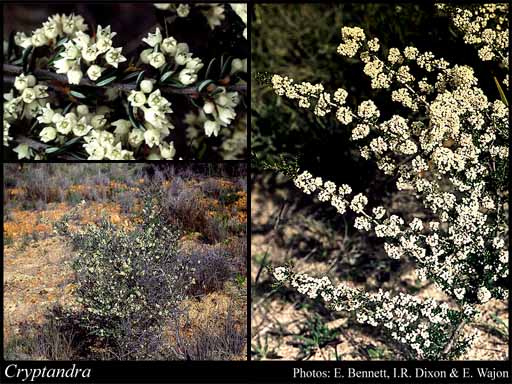- Reference
- Trans.Linn.Soc.London,Bot. 4:217 (1798)
- Name Status
- Current

Scientific Description
Common name. Cryptandras. Family Rhamnaceae.
The generic circumscription at present includes a number of species which will be segregated into new genera. The small groups are as follows (Rye pers. comm.): (a) C. wichurae + 1 south-eastern Queensland species, (b) C. intratropica + 2 others (see Rye 1997), and (c) C. mutila + C. pungens + 1 other. C. dielsii ms is likely to be segregated into a monotypic genus.
Habit and leaf form. Shrubs. ‘Normal’ plants. Leaves well developed. Plants with roots; non-succulent; spiny, or unarmed; autotrophic. To 1 m high (‘low shrub’). Self supporting. Not heterophyllous. Leaves small; not fasciculate, or fasciculate (C. nutans, C. pungens, C. glabriflora); alternate; with blades; petiolate, or petiolate, subsessile, and sessile (C. glabriflora, C. nutans); with ‘normal’ orientation; simple; not peltate. Leaf blades entire; flat, or solid (C. scoparia, C. glabriflora); semi-terete; linear, or ovate, or obovate, or oblong, or elliptic; pinnately veined. Mature leaf blades adaxially glabrous, or scabrous, or pubescent; abaxially glabrous, or scabrous, or pubescent (usually hairier than the adaxial surface). Leaves with stipules. Stipules scaly, or spiny; persistent. Leaf blade margins entire; revolute, or flat (or convex). Leaf anatomy. Hairs present, or absent.
Reproductive type, pollination. Fertile flowers hermaphrodite. Unisexual flowers absent. Plants hermaphrodite.
Inflorescence and flower features. Flowers aggregated in ‘inflorescences’, or solitary; in spikes, or in heads (or clusters). Inflorescences simple; axillary. Flowers pedicellate (includes most of the soon-to-be segregated taxa referred to earlier), or subsessile; bracteate; minute; regular; 5 merous; cyclic; tetracyclic. Free hypanthium present. Perianth with distinct calyx and corolla, or sepaline (C. apetala); 10, or 5; 2 -whorled, or 1 -whorled; isomerous. Calyx present; 5; 1 -whorled; gamosepalous; lobed; glabrous, or hairy; valvate; regular. Calyx lobes triangular. Epicalyx absent. Corolla present, or absent (C. apetala); 5, or 0; 1 -whorled, or 0 -whorled; alternating with the calyx; polypetalous; regular; hairy abaxially, or glabrous abaxially; hairy adaxially, or glabrous adaxially; white, or red. Petals triangular (when not clawed); clawed (when not triangular). Androecium present. Fertile stamens present. Androecial members definite in number. Androecium 5. Androecial members adnate (to the base of the floral tube); free of the gynoecium; free of one another; 1 -whorled. Stamens 5; all more or less similar in shape; isomerous with the perianth; alternisepalous; filantherous. Anthers separate from one another; dehiscing via longitudinal slits; bilocular; tetrasporangiate. Fertile gynoecium present. Gynoecium 3 carpelled, or 2 carpelled (C. intratropica), or 1 carpelled (C. micrantha Rye ms). The pistil 1 celled. Carpels reduced in number relative to the perianth. Gynoecium syncarpous, or monomerous; synstylovarious; inferior. Ovary plurilocular; 3 locular, or 2 locular, or 1 locular. Gynoecium stylate. Styles 1; apical. Stigmas 1–3 - lobed. Ovules 1 per locule (in WA); ascending; anatropous.
Fruit and seed features. Fruit aerial; ca 3 mm long; hairy, or not hairy; a schizocarp. Dispersal unit the seed. Seeds 1 per locule.
Geography, cytology, number of species. Native of Australia. Endemic to Australia. Australian states and territories: Western Australia, South Australia, Queensland, New South Wales, Victoria, Australian Capital Territory, and Tasmania. South-West Botanical Province. A genus of ca 40 species; ca 23 species in Western Australia; ca 21 endemic to Western Australia.
Etymology. From the Greek for "hidden" and "man"; the stamens are hidden by the hooded petals.